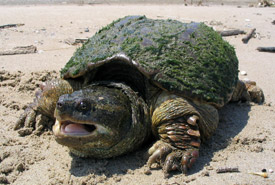Turtle conservation: The land between the waters

Snapping turtle (Photo by Ryan M. Bolton)
Many years ago I was surveying for endangered grassland birds in the treeless, sandy native prairies that straddle the Manitoba-Saskatchewan border. I came across a painted turtle walking determinedly towards...somewhere. The turtle and I were baking in the sun, literally hundreds of metres from any water body.
This was a bit confusing for me, as I always thought of Manitoba turtles as aquatic or semi-aquatic creatures, never far from the water.
Many years later, I have come to understand that when it comes to turtle conservation, aquatic habitat is important, but so is the land between the waters. Turtles move within waterbodies, but also occasionally between them — they disperse in search of new habitat, food, nest sites and mates.
The land cover and land management that occurs in between waterbodies can be as important to turtle conservation as the quality of the water itself.
In Manitoba, the Nature Conservancy of Canada (NCC) undertakes several land and water management activities that are beneficial to turtles:
- Inventory (systematic searches for turtles on NCC properties);
- Data sharing (for example, 98 NCC records of amphibians and reptiles were recently forwarded to the Manitoba Herps Atlas);
- Wetland restoration (which includes, where possible, the intentional sculpting of irregular wetland edges known to be beneficial to snapping turtles);
- Protection and improvement of water quality through the restoration and management of riparian areas;
- Restoration of uplands (prairies, forests, shrublands);
- Working with partners to coordinate response plans to invasive aquatic species; and
- Permanent protection of habitat.


